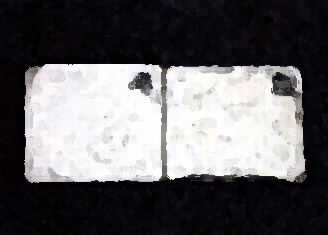testing
It's understandable that some would think that too much cyanuric acid - that is, the stabilizer used to keep the sun from destroying the chlorine in outdoor pools and spas - might be bad for the interior finish. It is, after all, acid, which instantly conjures images of surface corrosion and ruination. The fact of the matter, however, is that high cyanuric acid levels do not cause
When I conduct seminars at pool and spa industry trade shows, I regularly get asked about the validity of a water-management technique known widely as the “acid column” approach. Those who believe in this application method say that if acid is poured into a swimming pool in a concentrated area – producing what adherents variously call a column, slug, well or cloud – the alkalinity of the water will be drastically reduced, but the pH will not drop as much as it otherwise would. By contrast, they say, if that same volume of acid is added by walking it around a pool and evenly distributing it throughout the water, the pH will be
Every so often, our company is confronted by the belief among certain design professionals that, as it is used by the pool industry, shotcrete is simply not viable for use as structural concrete in high-profile watershaping projects. The assumption, I’ve learned, is that the pool industry is filled with contractors and specification writers who know little about the material and therefore tend to produce substandard results. I could argue the merits of the case, but let it suffice to say that the upshot of this widespread belief is that institutions and commercial clients hesitate to use shotcrete and instead prefer cast-in-place concrete, which they perceive as having greater quality and reliability in watershape applications. We at Drakeley Swimming Pool Co. (Bethlehem, Conn.) recently encountered exactly that prejudice: A private high school that was in the process of designing and building a state-of-the-art aquatic center and an
The death in 2002 of the granddaughter of former U.S. Secretary of State James Baker brought the problem of suction entrapment to unprecedented public attention. That incident - and others in which bathers have become stuck atop pool drains - have led to development of new legislation and pool-construction standards as well as increased awareness of the hazard. To me and some others, however, the new rules represent a reactive, regulatory solution to what might better be approached as a proactive matter of technology and engineering. In stepping back and carefully examining the anatomy of these terrible accidents, it becomes clear that, although steps can be taken to reduce risks, there is no single approach, given current design and construction practices, that will eliminate risks altogether. So far, in fact, all of the industry education and media attention we've witnessed is focused on solutions that at best mitigate entrapment hazards but do not eliminate them. These are not, unfortunately, approaches that lead us to complete and effective solutions. As an industry, we have not grappled with what I see as the true, addressable core of the issue
The death in 2002 of the granddaughter of former U.S. Secretary of State James Baker brought the problem of suction entrapment to unprecedented public attention. That incident - and others in which bathers have become stuck atop pool drains - have led to development of new legislation and pool-construction standards as well as increased awareness of the hazard. To me and some others, however, the new rules represent a reactive, regulatory solution to what might better be approached as a proactive matter of technology and engineering. In stepping back and carefully examining the anatomy of these terrible accidents, it becomes clear that, although steps can be taken to reduce risks, there is no single approach, given current design and construction practices, that will eliminate risks altogether. So far, in fact, all of the industry education and media attention we've witnessed is focused on solutions that at best mitigate entrapment hazards but do not eliminate them. These are not, unfortunately, approaches that lead us to complete and effective solutions. As an industry, we have not grappled with what I see as the true, addressable core of the issue
The death in 2002 of the granddaughter of former U.S. Secretary of State James Baker brought the problem of suction entrapment to unprecedented public attention. That incident - and others in which bathers have become stuck atop pool drains - have led to development of new legislation and pool-construction standards as well as increased awareness of the hazard. To me and some others, however, the new rules represent a reactive, regulatory solution to what might better be approached as a proactive matter of technology and engineering. In stepping back and carefully examining the anatomy of these terrible accidents, it becomes clear that, although steps can be taken to reduce risks, there is no single approach, given current design and construction practices, that will eliminate risks altogether. So far, in fact, all of the industry education and media attention we've witnessed is focused on solutions that at best mitigate entrapment hazards but do not eliminate them. These are not, unfortunately, approaches that lead us to complete and effective solutions. As an industry, we have not grappled with what I see as the true, addressable core of the issue
Even watershapers who don't perform daily tests of water quality in the systems they design and/or build will benefit from being familiar with the various methods available for water analysis, says Michael Gardner of Taylor Technologies. Such knowledge, he notes, helps in starting up new systems, formulating chemical-treatment regimens, calibrating automatic controllers or simply educating those who'll care for the watershapes you create.
The Crown Fountain in Chicago's Millennium Park is an ingenious fusion of artistic vision and high-tech water effects in which sculptor Juame Plensa' s creative concepts were brought to life by an interdisciplinary team that included the waterfeature designers at Crystal Fountains. Here, Larry O'Hearn describes how the firm met the challenge and helped give Chicago's residents a defining landmark in glass, light, water and bright faces. In July last year, the city of Chicago unveiled its newest civic landmark: Millennium Park, a world-class artistic and architectural extravaganza in the heart of downtown. At a cost of more than $475 million and in a process that took more than six years to complete, the park transformed a lakefront space once marked by unsightly railroad tracks and ugly parking
Watershapers are still fairly easily divided into two groups, one with its origins in the landscape trades, the other hailing from the pool industry. For all the distinctions that might be drawn between them, however, watershapers of all stripes have one very important thing in common: We all work with the stuff we find under our feet on the job site - the stuff we generally call dirt or soil. Dirt is the more inclusive of the two terms, and unless the contractor is working with a tricky site or faces compaction issues, it is simply what is carted away or rearranged to make room for a watershape. By contrast, soil is a blanket term covering



















